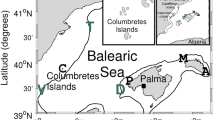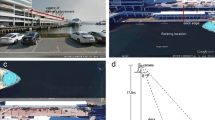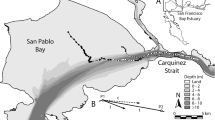Abstract
Animals swimming in tidal environments continuously interact with water currents which may either hinder or aid their movement. It is difficult to observe the orientation of an organism relative to the current when it is swimming in the wild without specialized telemetry; however, using the total recorded movement vector and the current vector, one can use vector analysis to calculate the actual movement of the animal. Here, we apply this method to six tracks of green sturgeon (Acipenser medirostris) in the San Francisco Estuary, using current vectors derived from a hydrodynamic model. Three movements were near the surface in deeper, high-current regions of the bay and three were near the bottom in shallow, low-current areas. The total displacement over ground was faster at the surface (0.9 m sec−1 versus 0.5 m sec−1) and occurred in stronger currents (0.7 m sec−1 versus 0.4 m sec−1), but the swimming speeds of the fish were similar between surface and bottom movements (0.5 m sec−1 versus 0.6 m sec−1). All surface movements were in the direction of the current, and two of the fish also oriented closely to the flow. In contrast, none of the three benthic movements were in the direction of the current, and two were oriented opposite to the flow. It seems plausible that green sturgeon orient to and make use of water currents to efficiently move through tidal habitats, riding the flow in high-current areas, and moving independently of, or even into, the flow in slower currents.








Similar content being viewed by others
References
Arnold GP (1981) Movements of fish in relation to water currents. In: Aidler DJ (ed) Animal migrations. Cambridge University Press, Cambridge, pp 55–79
Arnold GP, Greer-Walker M, Emerson LS, Holford BH (1994) Movements of cod (Gadus morhua L.) in relation to the tidal streams in the sourthern North Sea. ICES J Mar Sci 51:207–232
Bernatchez L, Dodson JJ (1987) Relationship between bioenergetics and behavior in anadromous fish migrations. Can J Fish Aq Sci 44:399–407
Blake RW (1979) The energetic of hovering in the mandarin fish (Synchropus picturatus). J Exp Biol 82:25–33
Cheng RT, Casulli V, Gartner JW (1993) Tidal, Residual, Intertidal Mudflat (TRIM) model and its applications to San Francisco Bay, California. Estuar Coast Shelf Sci
Conomos TJ, Peterson DH (1977) Suspended particle transport and circulation in San Francisco Bay: an overview. In: Wiley M (ed) Estuarine processes, vol. II. Academic, New York, pp 82–97
Conomos TJ, Smith RE, Garner JW (1985) Environmental setting of San Francisco Bay. Hydrobiologia 129:1–12
Creutzberg F (1961) On the orientation of migrating elvers (Anguilla vulgaris Turt.) in a tidal area. Neth J Sea Res 1:257–338
Erickson DL, Hightower JE (2007) Oceanic distribution and behavior of green sturgeon. Am Fish Soc Symp 56:197–211
Erickson DL, Webb MAH (2007) Spawning periodicity, spawning migration, and size at maturity of green sturgeon, Acipenser medirostris, in the Rogue River, Oregon. Environ Biol Fish 79(3–4):255–268
Forward RB, Tankersleyb RA, Reinsela KA (1998) Selective tidal stream transport of spot (Leistomus xanthurus Lacepede) and pinfish (Lagodon rhomboides Linnaeus) larvae: contribution of circatidal rhythms in activity. J Exp Mar Biol Ecol 226:19–32
Fox DA, Hightower JE, Parauka FM (2002) Estuarine and nearshore marine habitat use by gulf sturgeon from the Choctawhatchee River system, Florida. Am Fish Soc Symp 28:111–126
Greer Walker M, Harden Jones FR, Arnold GP (1978) The movements of plaice (Pleuronectes platessa L.) tracked in the open sea. ICES J Mar Sci 38:58–86
Greer Walker M, Riley JD, Emerson LS (1980) On the movements of sole (solea solea) and dogfish (Scyliorhinus canicula) tracked off the East Anglian Coast. Neth J Sea Res 14:66–77
Harden Jones FR (1980) The Nekton: production and migration patterns. In: Barnes RK, Mann KH (eds) Fundamentals of aquatic ecosystems. Blackwell Scientific Publications, Oxford, pp 119–142
Hettler WF, Barker DL (1993) Distribution and abundance of larval fishes at two North Carolina Inlets. Estuar Coast Shelf Sci 37:161–179
Heublein JC, Kelly JT, Crocker CE, Klimley AP, Lindley ST (2009) Migration of green sturgeon, Acipenser medirostris, in the Sacramento River. Environ Biol Fish 84(3):245–258
Jager Z (1999) Selective tidal stream transport of flounder larvae (Platichthys flesus L.) in the Dollard (Ems Estuary). Estuar Coast Shelf Sci 49:347–362
Kelly JT, Klimley AP, Crocker CE (2007) Movements of green sturgeon, Acipenser medirostris, in the San Francisco Bay Estuary, California. Environ Biol Fish 79(3–4):281–295
Klimley AP (1993) Highly directional swimming by the scalloped hammerhead sharks, Sphyrna lewini, and subsurface irradiance, temperature, bathymetry, and geomagnetic field. Mar Biol 117:1–22
Klimley AP, Beavers SC, Curtis TH, Jorgensen SJ (2002) Movements and swimming behavior of three species of sharks in La Jolla Canyon, California. Environ Biol Fish 63:117–135
Klimley AP, Kihslinger RL, Kelly JT (2005) Directional and non-directional movements of bat rays, Myliobatis californica, in Tomales Bay, California. Environ Biol Fish 74:79–88
Lankford SE, Adams TE, Miller RA, Cech JJ Jr (2005) The cost of chronic stress: impacts of a non-habituating stress response on metabolic variables and swimming performance in sturgeon. Physiol Biochem Zool 78(4):599–609
Levy DA, Cadenhead AD (1995) Selective tidal stream transport of adult sockeye salmon in the Fraser River Estuary. Can J Fish Aq Sci 52:1–12
Lindley ST, Moser ML, Erickson DL, Belchik M, Welch DW, Rechisky EL, Kelly JT, Heublein J, Klimley AP (2008) Marine migration of North American green sturgeon. Trans Am Fish Soc 137:182–194
McCleave JD, Fried SM, Towt AK (1977) Daily movements of shortnose sturgeon, Acipenser brevirostrum, in a marine estuary. Copeia 1977:149–157
Metcalfe JD, Arnold GP, Webb PW (1990) The energetics of migration by selective tidal stream transport: an analysis for plaice tracked in the southern North Sea. J Mar Biol Assoc UK 70:149–162
Metcalfe JD, Hunter E, Buckley AA (2006) The migratory behaviour of North Sea plaice: currents, clocks and clues. Mar Fresh Behav Physiol 39(1):25–36
Moser ML, Lindley ST (2007) Use of Washington estuaries by subadult and adult green sturgeon. Environ Biol Fish 79(3–4):243–253
Moser ML, Ross SW (1994) Effects of changing current regime and river discharge on the estuarine phase of anadromous fish migration. In: Dyer KR, Orth RJ (eds) Changes in fluxes in Estuaries: implications from science to management. Olsen and Olsen, Fredensborg, pp 343–347
Moyle PB (2002) Inland fishes of California. University of California Press, Berkeley
Nakamoto RJ, Kisanuki TT, Goldsmith GH (1995) Age and growth of Klamath River green sturgeon (Acipenser medirostris). U.S. Fish and Wildlife Service Report 93-FP-13, Yreka, CA
Nelson D (1987) The use of ultrasonic tracking in telemetry studies. In: Herrnkind WF, Thistle AB (eds) Signposts in the sea: proceedings of a multidisciplinary workshop on marine animal orientation and migration: 29–31 May 1986. Florida State University, Tallahassee, pp 118–129
Nowroozi BN, Strother JA, Horton JM, Summers AP, Brainerd EL (2009) Whole-body lift and ground effect during pectoral fin locomotion in the northern spearnose poacher (Agonopsis vulsa). Zool 112:393–402
Parker SJ, McCleave JD (1997) Selective tidal stream transport by American eels during homing movements and estuarine migration. J Mar Biol Assoc UK 77:871–889
Schoellhamer DH (2001) Influence of salinity, bottom topography, and tides on locations of estuarine turbidity maxima in northern San Francisco Bay. In: McAnally WH, Mehta AJ (eds) Coastal and estuarine fine sediment transport processes, Elsevier Science BV, pp 343–357
Sulak KJ, Clugston JP (1999) Recent advances in the life history of Gulf of Mexico sturgeon, Acipenser oxyrinchus desotoi, in the Suwannee River, Florida, USA: a synopsis. J Appl Ichthyol 15:116–128
Vogel S (1981) Life in moving fluids. Princeton University Press, Princeton
Weihs D (1978) Tidal stream transport as an efficient method for migration. ICES J Mar Sci 38(1):92–99
Wilga CD, Lauder GV (1999) Locomotion in sturgeon: function of the pectoral fins. J Exp Biol 202:2413–2432
Zar JH (1998) Biostatistical analysis, 4th edn. Prentice Hall, New Jersey
Acknowledgements
This research was funded by grants from the US Fish and Wildlife Service Anadromous Fish Restoration Program and CALFED Ecosystem Restoration Program. GIS bathymetry data were provided by W. Patterson, California Department of Fish and Game, Information Technology Division, Sacramento, California. We are indebted to our colleague C. Crocker who devoted extensive time, effort, and boat support during the field phase of this study. P. Sandstrom collected the field measurements of currents. Capture of sturgeon would not have been possible without the efforts of N. Kogut, R. Schaffter, D. Kohlhorst, M. Silva, and the field staff of the CDFG Bay/Delta Branch. Thanks also to J. Cech Jr., R. Kihslinger, S. Lankford, V. Wunderlich and all those that volunteered their time and efforts. This manuscript benefited from reviews by M. Gard, J. Cech Jr., G. Nevitt, R. Kihslinger, L. Rabin.
Author information
Authors and Affiliations
Corresponding author
Rights and permissions
About this article
Cite this article
Kelly, J.T., Klimley, A.P. Relating the swimming movements of green sturgeon to the movement of water currents. Environ Biol Fish 93, 151–167 (2012). https://doi.org/10.1007/s10641-011-9898-8
Received:
Accepted:
Published:
Issue Date:
DOI: https://doi.org/10.1007/s10641-011-9898-8




